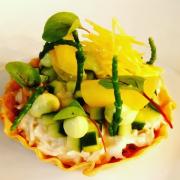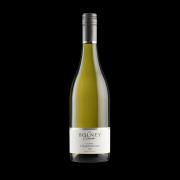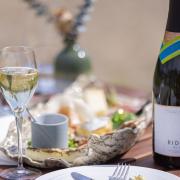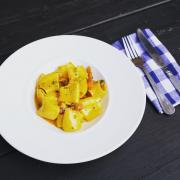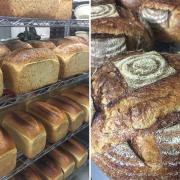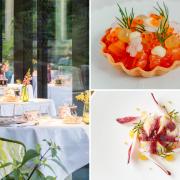Fed up with the high-speed rat race, many people are now going on ‘rewilding’ trips in search of food – and themselves – in the Sussex woods and coastlines. Katie Scott joins three foraging experts
It’s 7am and a tall man is striding across an empty Sussex beach. The sun is shining in an ice blue sky whilst distant waves and a light wind send ripples across the rock pools. Behind him, chalky cliffs topped with sparse grass mark where the South Downs meet the coast. A village once stood at this spot but has long since been claimed by the sea.
Every now and then, the man pauses and crouches down, searching for something specific. This is the first day this year that the tide has been low during daylight hours. He stops again, ushers me over and points to a brown seaweed. He pulls off a frilly frond, explains it’s Pepper Dulse - one of the first seaweeds to appear each year - and I tentatively taste it. It’s a surprisingly intense mix of salt, garlic and truffle.
My guide is Geoff Dann, a 54-year old professional foraging teacher and author of two of the most comprehensive guides to what you can, and cannot eat, from the natural world. His first book, Edible Mushrooms, was published in 2016 and covers about 450 edible and toxic fungi recorded as present in the British Isles and the temperate zones of Europe. He followed this epic guide to mycophagy with Edible Plants, a 500-plus page tome, published this year, and is similarly forensic in its study and philosophical in approach.
It is from these pages that Geoff has picked a recipe for today though the seaweed needed is proving elusive. As he wanders and scans, Geoff points to copious patches of Sea Lettuce, which contains high levels of vitamins A, B3, B12 and C, and the highest Iron content of any European seaweed. It tastes inoffensive and bland - the perfect superfood.
A foraged feast

It is a red, wispy seaweed called Gracilaria or Ogonori that we want and Geoff finally finds it. It is a small patch that will become far bigger as summer approaches. It is also a source of agar - a vegetarian alternative to gelatine which, writes Geoff in his book, ‘...has [also] long been used to provide a solid substrate for microbiological research’.

Today, it’s our lunch - blanched back at Geoff’s home in Hastings and then served with salted cucumber, sliced shallots, chilli, ginger and a Japanese-Hawaiian style dressing. It is fresh and subtly flavoured. Geoff shares his with his wife Cathy before disappearing to bring back a slipper clam - also harvested today - and some Alexanders taken from a beachside walkway. A Roman introduction, this biennial herb has sadly fallen out of popularity although Geoff shares that Silo in Brighton is using the pollen in one of its salads. He prepares its stalks with butter, salt and pepper, and we savour its celery-like flavour.
The pandemic brought about a bloom in interest in foraging. When our movements became restricted, what was growing in our little patches of green became fascinating.
Megan Howlett is kneeling down collecting primrose flowers when a deer bounds past us. She only takes friends and family foraging with her but has 189,000 followers on TikTok as @thegardencottage, more than half of which are in the US. In August 2021, the 24-year old also featured in an article about foraging in i-D magazine.

It was childhood days spent with her grandparents in North Wales that gave her a basic understanding of foraging but it became an escape for her during the stress of her degree. ‘Gen Z seems to be leading the move back to basics,’ Megan says, ‘They have grown up seeing lots of mental health problems caused by the lifestyles we lead.’ Megan walks slowly along the woodland path near Billingshurst, chatting and searching. She spots a wild strawberry plant hiding under another plant. I never would have seen it. She goes foraging at least twice a week - sometimes more - and now has an intricate knowledge of what grows near her home in Midhurst. She and her partner hope to buy a small holding and rewild the plot so she can forage on her own land.
Witchy Room
This is an ancient woodland, she explains, pointing to a carpet of Dog’s Mercury, a plant that shows that this area near Billingshurst has been relatively untouched for more than 100 years. She adds Forget-me-Not and Wild Sweet Violet flowers to her basket; points out the stunningly beautiful, but toxic Wood Anemones and hands me a ground elder leaf to chew. Another Roman import - it has a tinge of parsley and is a great addition to pesto's. The Wild Garlic is a spring favourite – its' leaves will blow up in a pan like poppadoms she tells me - while Wild Camomile is her summer harvest of choice though this year, Howlett will be foraging for her bridal bouquet.
She is quietly spoken and hugely knowledgeable. She professes to spending vast amounts of time researching plants and recipes; and is especially fascinated by names that harken to times when people were so much more aware of what was growing nearby - Creeping Charlie, Jack by the Hedge, Lady’s Smock to list but a few of these evocative nicknames. She also shares often lost knowledge of their powers. She explains the anti-inflammatory properties of Nettles and how pine sap can seal up cuts; and reveals that her spare room is full of demijohns for wines; jars of petals and leaves; and various pots of powders and balms. ‘My partner calls it my witchy room,’ she laughs.
Like Geoff, she emphasises the responsibility of foragers to be sustainable in their pursuits. In Edible Plants, he details humanity's evolution from hunter gatherers to sedentary farming; and our resultant dependence on cultivated crops (although people have always continued to forage). We now dominate our natural world to fit our will. To those happy with this status-quo, foragers are perhaps just ‘romantic dreamers pining for a lost way of life that in reality must have been nasty, brutish and short,’ writes Geoff, but perhaps our ancestors were wiser than us. ‘Their way of life was absolutely sustainable. Ours, regardless of science and technology that would look like magic to them, is absolutely not,’ he states.

Fern Freud has picked this spot for us to sit because it’s where she often sees a woodpecker. We can hear him in the distance but he doesn’t grace us with his presence. Instead, we talk, sitting on a rug in dappled sunlight whilst her dog scrabbles nearby. A kettle boils over a little stove for our Dandelion Root Coffee as we eat nettle cakes that have a delicate lemon flavour and are decorated with edible flowers. Freud leads foraging classes but, like Megan, also has a huge following on Instagram and TikTok where she has shared videos on everything from Lilac donuts to Parasol mushroom goujons.
Foraging Forebears
We meet in a secret corner of Worthing, nestled behind houses, in a woodland she knows and loves. Within minutes, she spots some wild lilac flowers. These, she shares, are said to have sprouted where the tears of the nymph Io fell. The poor sprite had been transformed into a cow by the over-amorous King of the Gods, Zeus, in a bid to hide her from his wife. Tormented by the prospect of an eternity eating grass, Zeus showed her pity by creating the sweet tasting flower as she wept. For Freud and Howlett, these stories connect us and our foraging forebears; but also imbue plants the majority of us barely notice with a magical past. As Geoff writes: ‘They [our ancestors] believed the world had always been the way it was, and would always be that way, and that the natural and spiritual realm were one and the same, and would always provide what was needed.’
Worthing-based Fern returns to spots in every season noting how plants change their appearance and properties as the year progresses. This is beautiful to watch but also essential if you are to learn to recognise plants, especially ones like Cow Parsley, that bear a strong resemblance to deadly species (in its case - Hemlock). Freud jokes she is often called “that mushroom lady” and knowledge is especially important when it comes to funghi. As a child, she and her siblings would head out with their dad into muddy Sussex fields to find mushrooms. She says she learnt quickly as she wasn't always confident that her family’s finds weren’t dubious (or dangerous).
Fern hopes to share her wisdom in print one day and is working with a publisher for a launch next year. ‘I have this picture in my head of being a crazy, witchy old lady, sitting in an armchair with all of my books on the shelves behind me,’ she laughs. She is also hoping to include some of the seasonal rituals she values. Already, Fern marks the seasons changing with women's wellness workshops, which include healing rituals, time to relax in an outdoor spa and a foraged, shared meal. This is part of her commitment to the wider Slow Movement, which she advocates as we wander. ‘It doesn’t make sense that that wouldn’t be our goal as human beings,’ she states before kneeling to pick a Sorrel leaf - apparently an early alternative to citrus fruits.
As we wander back from green paths to grey pavement, I get the sense that the foragers I have met are both carrying on old traditions - and educating others about them - but also offering a potential path for the future. We are aware that carbohydrate-rich, processed foods are bad for us; but also, and perhaps especially after the pandemic, so is the high-pressured, high-speed existence many of us accept. Perhaps by “rewilding” ourselves and our families - by simply walking in the woods; noticing what’s around us and even exploring the possibilities of foraging, we can help ourselves physically and mentally. As Geoff writes: 'There is a growing trend for doing this [foraging] with children, as well as adults tired of the rat-race. Teach them in the woods, where it is wilder and muddier, rather than in the sanitised indoor world and the artificial environment of playgrounds. Maybe sow a few mental seeds and hope the next generation is slightly less messed up than we are.'
Recipes: Three Foraging Favourites
Make a dish designed by one of our foraging experts
Geoff Dann's Ogonori Salad

¼ cucumber
3 tbsp rice vinegar
2 tbsp light soy sauce
1 tbsp toasted sesame oil
1 tsp honey
80g fresh ogonori
3 shallots (thinly sliced with a mandoline)
1 fresh red chilli (chopped or finely sliced)
2cm fresh grated root ginger,
black sesame seeds.
Slice the cucumber thinly, cover with salt, leave for 20-30 mins; then drain and pat off any excess salt. The goal is to get rid of as much water as possible - gently squeezing will help.
Mix the rice vinegar, soy sauce, sesame oil and honey to make a dressing. Chop the Ogonori into 4-5cm lengths.
Blanch the Ogonori in boiling water for 40 seconds, then immediately rinse in cold water, to keep it nice and crunchy.
Place a layer of salted cucumber and sliced shallots in a circle on a plate. Mix the Ogonori with the chilli and ginger, and place in the middle of the circle. Pour the dressing onto the mixture, and garnish with sesame seeds.
Megan Howlett's Wild magnolia cookies

200 grams caster sugar
200 grams (vegan) butter
pinch of sea salt
1/4 tsp of vanilla extract
4 small Magnolia flowers sliced thinly
400 grams flour
edible wild flowers.
Preheat the oven to 180C and grease a baking tray. Whisk together the sugar and (vegan) butter until the sugar is incorporated then whisk in the sea salt and vanilla extract. Stir in the Magnolia petals. Sieve in the flour and mix until a dough forms. Let it refrigerate for 20 minutes. Roll out the dough to roughly 1/2 inches thick and then, using a cookie cutter, divide the dough into cookie shapes. Lay these on the baking tray and bake for six minutes (you may need to do two or three batches). Whilst still warm, roll the flowers into the dough so that they lay flat. Allow to cool and serve.
Fern Freud's Nettle cake with elderflower buttercream frosting
100g foraged nettle tops
200g plant milk
1 tbsp lemon juice
75ml vegetable oil
200g caster sugar
250g plain flour
1 tsp bicarbonate of soda
zest of one lemon
a pinch of salt
For the frosting
100g butter
300g icing sugar
60ml of elderflower syrup or cordia
Preheat the oven to 170 degrees C (Gas Mark 4) and line and grease two nine inch round baking tins. Forage the nettle tops (only pick the top 6-8 leaves). I use the whole nettle top because I have a good blender BUT if yours isn’t very good, cut the leaves away from the stems and use the leaves only. Give them a good wash and then steam for four minutes. Transfer them to cold water. Strain and squeeze out excess moisture.
Blend with the plant milk and lemon juice until you have a smooth purée. Place in a bowl with the vegetable oil and stir well. Add the caster sugar, flour and bicarbonate of soda, the lemon zest and salt. Pour into your cake tin and bake for 35-40 minutes or until a wooden skewer comes out clean.
For the buttercream, simply whip the butter until light and fluffy, beat in the icing sugar and then add the elderflower syrup or cordial.
Geoff Dann https://www.geoffdann.co.uk/
Foraged by Fern: https://www.foragedbyfern.com/
Megan Howlett: https://www.tiktok.com/@thegardencottage?lang=en





